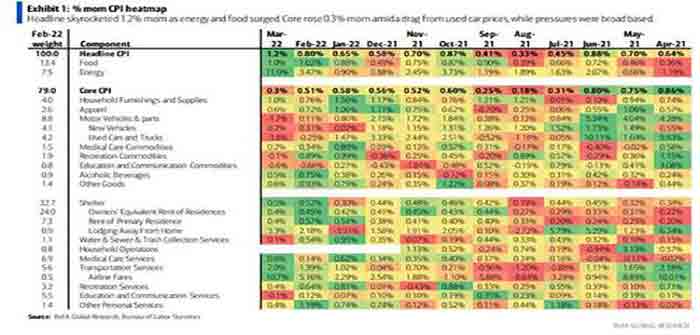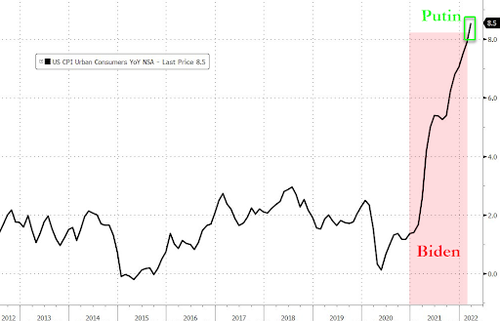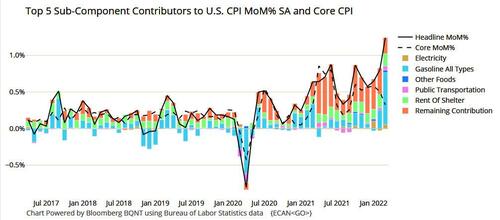
by Tyler Durden at ZeroHedge
In the latest inflationary shock – one which Biden will dutifully read from the teleprompter was entirely the fault of “PutInflation” – even if a chart of CPI in context shows otherwise…
… this morning the BLS reported that headline CPI skyrocketed 1.2% (1.24% unrounded) M/M in March as energy surged 11.0% and food prices jumped 1.0% mom for a second consecutive month. The energy price moves reflect the shock from the Russia-Ukraine conflict, while food has yet to feel the impact given lagged pass-through and is likely to remain hot throughout the year. In other words, while much of the covid-linked supply chain inflationary spike is fading, we are about to face an even bigger, Ukraine-war food inflation spike!
Core CPI came in slightly softer than expected at a still elevated 0.3% (0.32 unrounded) mom. As noted earlier, the miss owed to a 3.8% plunge in used auto prices, which sliced 20bps from the monthly core drop.
Meanwhile, new cars continued to head higher, with a 0.2% mom increase, as did medical commodities. HH furnishings/supplies stayed hot, with a 1.0% mom gain, as did apparel, with a 0.6% rise in March—these two components have shown greater
sensitivity to ongoing supply-chain tightness. Here is a snapshot
- Grocery inflation jumps 10.0% in March vs. the February rate of +8.6%.
- Cereals and Bakery Products +9.4%, Meats, Poultry, Fish, and Eggs were +13.7%
- Dairy and Related Products were +7.0% Fruits and Vegetables were +8.5%
- Airfares in March skyrocketed 10.7% and are now at their highest point since the pandemic began.
- Shelter inflation 5.0% Y/Y in March vs 4.7% in Feb, and the highest since May 1991
- Rent inflation 4.44% Y/Y in March vs 4.17% in Feb, and the highest since May 2007
- The household furnishings and operations index rose 1.0%, the eighth consecutive increase
- The index for new vehicles increased 0.2 percent in March after rising 0.3 percent the previous month.
- The index for communication was also among those few indexes which declined over the month, falling 0.5 percent
The only materially lower category, as noted above, was the index for used cars and trucks which fell 3.8 percent in March, its second consecutive monthly decline after a series of large increases…
Continue Reading

